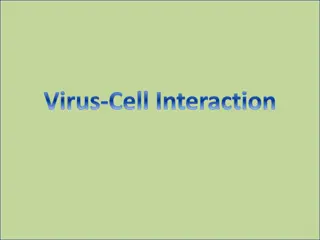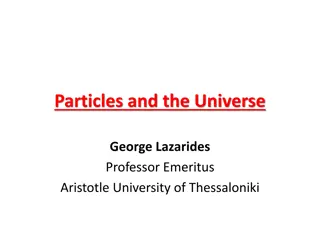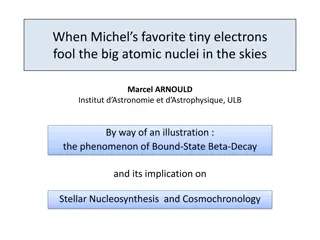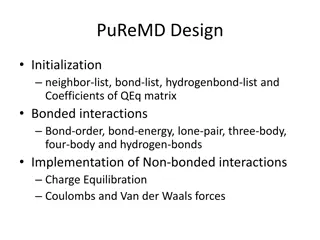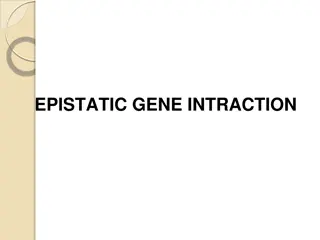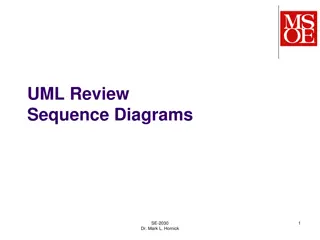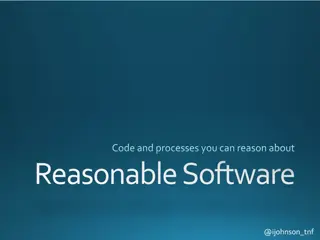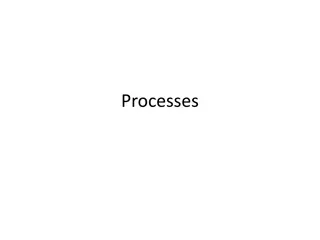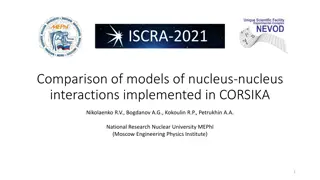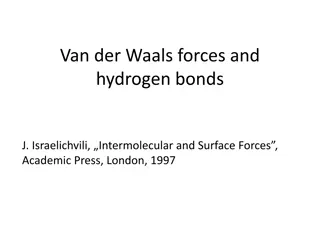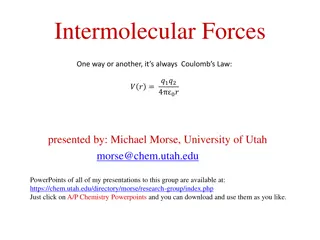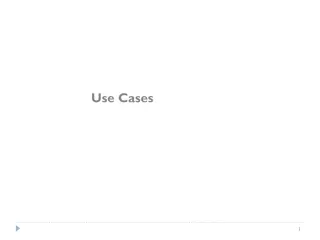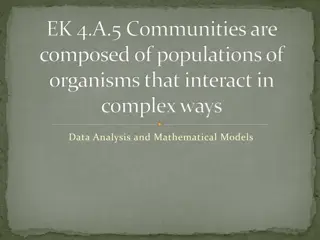Processes and Interactions
Processes in operating systems involve executing programs on CPUs, with each process having its own CPU. Processes run concurrently and can cooperate or compete for resources. Defining, creating, and managing processes is crucial for system efficiency and performance. Precedence relations, semaphores, and process interactions play key roles in ensuring proper functioning of processes.
Download Presentation

Please find below an Image/Link to download the presentation.
The content on the website is provided AS IS for your information and personal use only. It may not be sold, licensed, or shared on other websites without obtaining consent from the author.If you encounter any issues during the download, it is possible that the publisher has removed the file from their server.
You are allowed to download the files provided on this website for personal or commercial use, subject to the condition that they are used lawfully. All files are the property of their respective owners.
The content on the website is provided AS IS for your information and personal use only. It may not be sold, licensed, or shared on other websites without obtaining consent from the author.
E N D
Presentation Transcript
2. Processes and Interactions 2.1 The Process Notion 2.2 Defining and Instantiating Processes Precedence Relations Implicit Process Creation Dynamic Creation With fork And join 2.3 Basic Process Interactions Competition: The Critical Section Problem Cooperation 2.4 Semaphores Semaphore Operations and Data Mutual Exclusion Producer/Consumer Situations Operating Systems 1
Processes A process is the activity of executing a program on a CPU. Conceptually Each process has its own CPU Processes are running concurrently Physical concurrency = parallelism This requires multiple CPUs Logical concurrency = time-shared CPU Processes cooperate (shared memory, messages, synchronization) Processes compete for resources Operating Systems 2
Why Processes? Hardware-independent solutions Processes cooperate and compete correctly, regardless of the number of CPUs Structuring mechanism Tasks are isolated with well-defined interfaces Operating Systems 3
How to define/create Processes? Need to: Define what each process does (the program) Create the processes (data structure/PCB) Subject of another chapter Specify precedence relations: when processes start and stop executing, relative to each other Operating Systems 4
Specifying precedence relations A general approach: Process flow graphs Directed acyclic graphs (DAGs) Edges = processes Vertices = starting and ending points of processes Operating Systems 5
Process flow graphs Example: parallel evaluation of arithmetic expression: (a + b) * (c + d) - (e / f) Operating Systems 6
Process flow graphs Other examples of Precedence Relationships Operating Systems 7
Process flow graphs (PFG) Challenge: devise programming language constructs to capture PFG Special case: Properly Nested Graphs A graph is properly nested if it corresponds to a properly nested expression, where S(p1, p2, ) describes serial execution of p1, p2, P(p1, p2, ) describes parallel execution of p1, p2, Operating Systems 8
Process flow graphs Strictly sequential or strictly parallel execution (a) S(p1, p2, p3, p4) (b) P(p1, p2, p3, p4) Operating Systems 9
Process flow graphs (c) corresponds to the properly nested expression: S(p1, P(p2, S(p3, P(p4, p5)), p6), P(p7, p8)) (d) is not properly nested (proof: text, page 44) Operating Systems 10
Language Constructs for Process Creation to capture properly nested graphs cobegin // coend forall statement to capture unrestricted graphs fork/join/quit Operating Systems 11
cobegin/coend statements syntax: cobegin C1 // C2// // Cn coend meaning: all Ci may proceed concurrently when all Ci s terminate, next statement can proceed cobegin/coend are analogous to S/P notation S(a,b) a; b (sequential execution by default) P(a,b) cobegin a // b coend Operating Systems 12
cobegin/coend example cobegin Time_Date // Mail // { Edit; cobegin { Compile; Load; Execute} // { Edit; cobegin Print // Web coend} coend } coend Operating Systems 13
Data parallelism Samecode is applied to differentdata The forall statement syntax: forall (parameters) statements meaning: Parameters specify set of data items Statements are executed for each item concurrently Operating Systems 14
Example of forall statement Example: Matrix Multiply A=B*C forall ( i:1..n, j:1..m ) { A[i][j] = 0; for ( k=1; k<=r; ++k ) A[i][j] = A[i][j] + B[i][k]*C[k][j]; } Each inner product is computed sequentially All inner products are computed in parallel Operating Systems 15
fork/join/quit cobegin/coend limited to properly nested graphs forall limited to data parallelism fork/join/quit can express arbitrary functional parallelism (any process flow graph) Operating Systems 16
fork/join/quit Syntax: fork x Meaning: create new process that begins executing at label x Syntax: join t,y Meaning: t = t 1; if (t==0) goto y; Syntax: quit Meaning: terminate current process Operating Systems 17
fork/join/quit example A simple Example: execute x and y concurrently when both finish, execute z t = 2; fork L1; fork L2; quit; L1: x; join t,L3; quit L2: y; join t,L3; quit; L3: z; Better: t = 2; fork L2; x; join t,L3; quit; L2: y; join t,L3; quit L3: z; Operating Systems 18
fork/join/quit example Example: Graph in Figure 2-1(d) t1 = 2; t2 = 3; p1; fork L2; fork L5; fork L7; quit; L2: p2; fork L3; fork L4; quit; L5: p5; join t1,L6; quit; L7: p7; join t2,L8; quit; L4: p4; join t1,L6; quit; L3: p3; join t2,L8; quit; L6: p6; join t2,L8; quit; L8: p8; quit; Operating Systems 19
Example: the Unix fork statement procid = fork() Replicates calling process Parent and child are identical except for the value of procid Use procid to diverge parent and child: if (procid==0) do_child_processing else do_parent_processing Operating Systems 20
Process Interactions Competition Two processes both want to access the same resource Example: write the same file, use the same printer Requires mutual exclusion Cooperation Two processes work on a common problem Example: Producer Buffer Requires coordination Consumer Operating Systems 23
Process Interactions Competition: The Critical Section Problem x = 0; cobegin p1: x = x + 1; // p2: x = x + 1; coend After both processes execute, we should have x=2, but Operating Systems 24
The Critical Section Problem Interleaved execution (due to parallel processing or context switching) p1: R1 = x; p2: R2 = x; R1 = R1 + 1; R2 = R2 + 1; x = R1 ; x = R2; x has only been incremented once. The first update (x = R1) is lost. Operating Systems 25
The Critical Section Problem General problem statement: cobegin p1: while(1) {CS1; program1;} // p2: while(1) {CS2; program2;} // ... // pn: while(1) {CSn; programn;} coend Guarantee mutual exclusion: At any time, at most one process should be executing within its critical section (CSi). Operating Systems 26
The Critical Section Problem In addition to mutualexclusion, must also prevent mutualblocking: 1. Process outside of its CS must not prevent other processes from entering its CS (no dog in manger ) 2. Process must not be able to repeatedly reenter its CS and starve other processes (fairness) 3. Processes must not block each other forever (no deadlock) 4. Processes must not repeatedly yield to each other ( after you after you ) (no livelock) Operating Systems 27
The Critical Section Problem Solving the problem is subtle We will examine a few incorrect solutions before describing a correct one: Peterson s algorithm Operating Systems 28
Attempt 1 (incorrect) Use a single turn variable: int turn = 1; cobegin p1: while (1) { while (turn != 1); /*wait*/ CS1; turn = 2; program1; } // p2: while (1) { while (turn != 2); /*wait*/ CS2; turn = 1; program2; } coend Violates blocking requirement (1), dog in manger Operating Systems 29
Attempt 2 (incorrect) Use two variables: c1=1 when p1 wants to enter its CS. c2=1 when p2 wants to enter its CS. int c1 = 0, c2 = 0; cobegin p1: while (1) { c1 = 1; while (c2); /*wait*/ CS1; c1 = 0; program1; } // p2: while (1) { c2 = 1; while (c1); /*wait*/ CS2; c2 = 0; program2; } coend Violates blocking requirement (3), deadlock. Operating Systems 30
Attempt 3 (incorrect) Like #2, but reset intent variables (c1 and c2) each time: int c1 = 0, c2 = 0; cobegin p1: while (1) { c1 = 1; if (c2) c1 = 0; //go back, try again else {CS1; c1 = 0; program1} } // p2: while (1) { c2 = 1; if (c1) c2 = 0; //go back, try again else {CS2; c2 = 0; program2} } coend Violates livelock (4) and starvation (2) requirements Operating Systems 31
Petersons algorithm Processes indicate intent to enter CS as in #2 and #3 (by setting c1 or c2) After a process indicates its intent to enter, it (politely) tells the other that it will wait if necessary (using willWait) It then waits until one of the following is true: The other process is not trying to enter; or The other process has said that it will wait (by changing the value of the willWait variable.) Shared variable willWait is the key: with #3: both processes can reset c1/c2 simultaneously with Peterson: willWait can only have a single value Operating Systems 32
Petersons Algorithm int c1 = 0, c2 = 0, willWait; cobegin p1: while (1) { c1 = 1; willWait = 1; while (c2 && (willWait==1)); /*wait*/ CS1; c1 = 0; program1; } // p2: while (1) { c2 = 1; willWait = 2; while (c1 && (willWait==2)); /*wait*/ CS2; c2 = 0; program2; } coend Guarantees mutual exclusion and no blocking Operating Systems 33
Software solutions to CS problem Drawbacks Difficult to program and to verify Processes loop while waiting (busy-wait). Applicable to only to CS problem: competition. Does not address cooperation among processes. Need a better, more general solution: semaphores semaphore-based high-level constructs, such as monitors Operating Systems 36
Semaphores A semaphores is a nonnegative integer OperationsP and Vare defined on s Semantics: P(s): while (s<1) /*wait*/; s=s-1 V(s): s=s+1; The operationsP and Vare atomic (indivisible) If more than one process invokes P simultaneously, their execution is sequential and in arbitrary order If more than one process is waiting in P, an arbitrary one continues when s>0 Assume we have such operations (chapter 3) Operating Systems 37
Notes on semaphores Developed by Edsger Dijkstra http://en.wikipedia.org/wiki/Edsger_W._Dijkstra Etymology: P(s): P from passaren ( pass in Dutch) or from prolagen, which combines proberen ( try ) and verlagen ( decrease ) V(s) V from vrigeven ( release ) or verhogen ( increase ) Operating Systems 38
Mutual Exclusion w/ Semaphores Assume we have P/V as defined previously semaphore mutex = 1; cobegin p1: while (1) { P(mutex); CS1; V(mutex); program1;} // p2: while (1) { P(mutex); CS2; V(mutex); program2;} // ... pn: while (1) { P(mutex); CSn; V(mutex); programn;} coend; Operating Systems 39
Cooperation Semaphores can also solve cooperation problems Example: assume that p1 must wait for a signal from p2 before proceeding. semaphore s = 0; cobegin p1: ... P(s); /* wait for signal */ ... // p2: ... V(s); /* send signal */ ... coend; Operating Systems 40
Bounded Buffer Problem Classic generic scenario: Producer Buffer Produce and consumer run concurrently Buffer has a finitesize (# of elements) Consumer may remove elements from buffer as long as it is not empty Producer may add data elements to the buffer as long as it is not full Access to buffer must be exclusive (critical section) Consumer Operating Systems 41
Bounded Buffer Problem semaphore e = n, f = 0, b = 1; cobegin Producer: while (1) { Produce_next_record; P(e); P(b); Add_to_buf; V(b); V(f); } // Consumer: while (1) { P(f); P(b); Take_from_buf; V(b); V(e); Process_record; } coend Operating Systems 42


